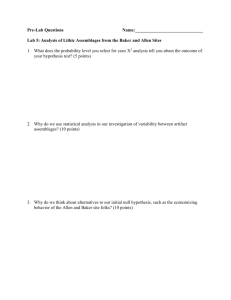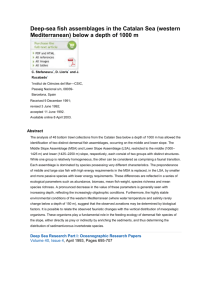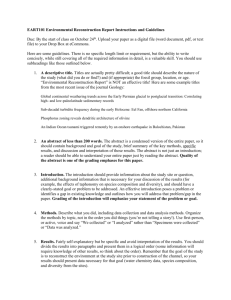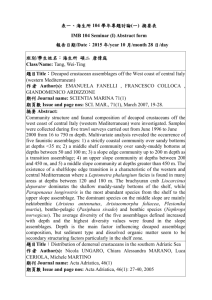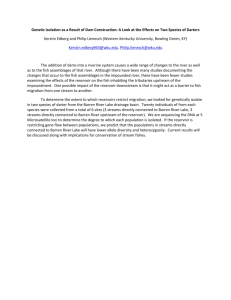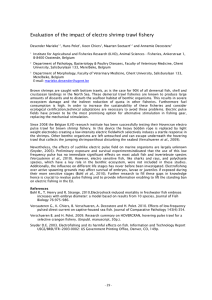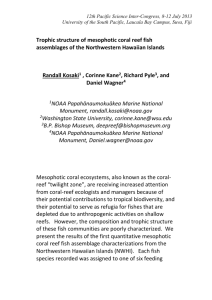ICES CM 2007/
advertisement
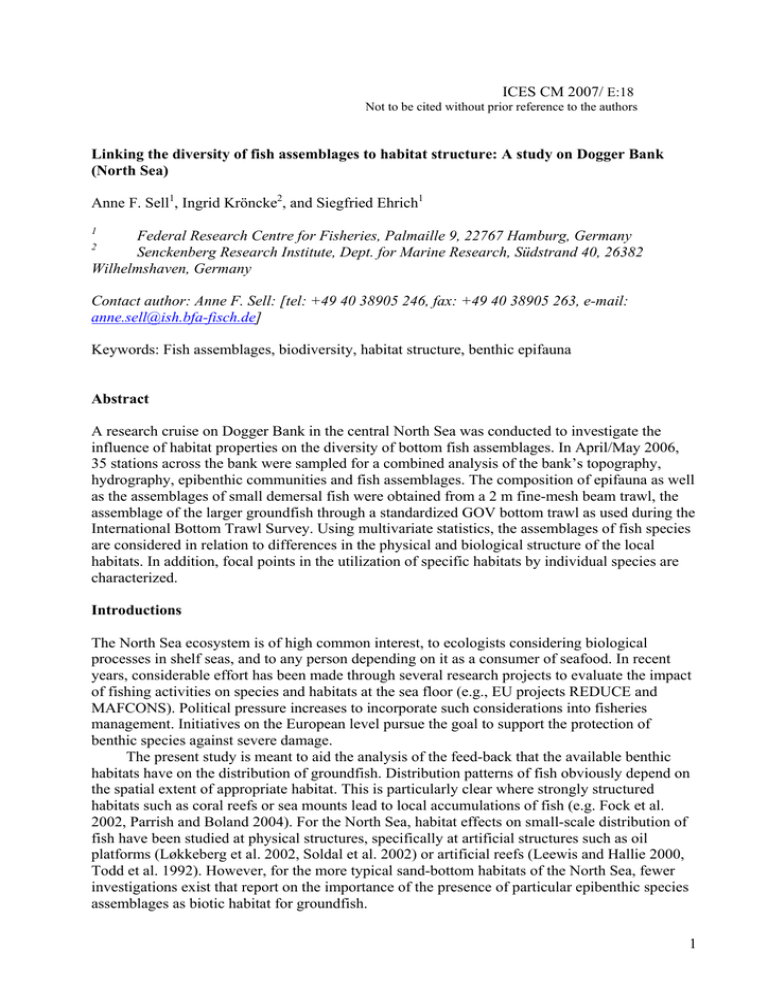
ICES CM 2007/ E:18 Not to be cited without prior reference to the authors Linking the diversity of fish assemblages to habitat structure: A study on Dogger Bank (North Sea) Anne F. Sell1, Ingrid Kröncke2, and Siegfried Ehrich1 1 Federal Research Centre for Fisheries, Palmaille 9, 22767 Hamburg, Germany Senckenberg Research Institute, Dept. for Marine Research, Südstrand 40, 26382 Wilhelmshaven, Germany 2 Contact author: Anne F. Sell: [tel: +49 40 38905 246, fax: +49 40 38905 263, e-mail: anne.sell@ish.bfa-fisch.de] Keywords: Fish assemblages, biodiversity, habitat structure, benthic epifauna Abstract A research cruise on Dogger Bank in the central North Sea was conducted to investigate the influence of habitat properties on the diversity of bottom fish assemblages. In April/May 2006, 35 stations across the bank were sampled for a combined analysis of the bank’s topography, hydrography, epibenthic communities and fish assemblages. The composition of epifauna as well as the assemblages of small demersal fish were obtained from a 2 m fine-mesh beam trawl, the assemblage of the larger groundfish through a standardized GOV bottom trawl as used during the International Bottom Trawl Survey. Using multivariate statistics, the assemblages of fish species are considered in relation to differences in the physical and biological structure of the local habitats. In addition, focal points in the utilization of specific habitats by individual species are characterized. Introductions The North Sea ecosystem is of high common interest, to ecologists considering biological processes in shelf seas, and to any person depending on it as a consumer of seafood. In recent years, considerable effort has been made through several research projects to evaluate the impact of fishing activities on species and habitats at the sea floor (e.g., EU projects REDUCE and MAFCONS). Political pressure increases to incorporate such considerations into fisheries management. Initiatives on the European level pursue the goal to support the protection of benthic species against severe damage. The present study is meant to aid the analysis of the feed-back that the available benthic habitats have on the distribution of groundfish. Distribution patterns of fish obviously depend on the spatial extent of appropriate habitat. This is particularly clear where strongly structured habitats such as coral reefs or sea mounts lead to local accumulations of fish (e.g. Fock et al. 2002, Parrish and Boland 2004). For the North Sea, habitat effects on small-scale distribution of fish have been studied at physical structures, specifically at artificial structures such as oil platforms (Løkkeberg et al. 2002, Soldal et al. 2002) or artificial reefs (Leewis and Hallie 2000, Todd et al. 1992). However, for the more typical sand-bottom habitats of the North Sea, fewer investigations exist that report on the importance of the presence of particular epibenthic species assemblages as biotic habitat for groundfish. 1 The Dogger Bank is a special ecological region (Kröncke & Knust 1995) characterized by its low depth, sandy sediments, the occurrence of fronts (Bo Pedersen 1994; Nielsen et al. 1993), subsurface phytoplankton blooms (Riegman et al. 1990; Nielsen et al. 1993; Richardson et al. 1998) and high primary production continuing throughout the year (Brockmann & Wegner 1985; Richardson & Olsen 1987; Brockmann et al. 1990). Residual current direction in the Dogger Bank area is highly variable and strongly influenced by the prevailing wind directions (Lee 1980). The different water masses of the Dogger Bank are characterized by different salinities, temperatures and seasonal variability in temperature. The water masses in the shallow areas on top of the bank are nearly permanently mixed, whereas in the deeper areas around the Dogger Bank seasonal stratification occurs. The variability of the bottom water temperature in the shallow parts ranges between 5 – 16 °C. In the deeper areas south and especially north of the bank seasonal temperature differences are less pronounced (Otto et al. 1990). Both factors, morphological heterogeneity as well as the co-occurrence of different water masses, are known to support the development of fronts (Otto et al. 1990). Fronts achieved considerable attention for their potential role as sites of enhanced primary and secondary production (Hill et al. 1994). Indeed, several investigations suggested that the Dogger Bank waters are more productive than the surrounding deeper waters. Primary production occurs throughout the year with higher values in winter (January and February) than in any other area in the southern North Sea (Brockmann & Wegner 1985, Richardson & Olsen 1987, Brockmann et al. 1990, Howarth et al. 1994). The south-western part of the Dogger Bank is influenced by the Flamborough frontal system (Hill et al. 1994), which coincides with elevated primary production and an enriched benthic zone in the southern North Sea (Frisian Front) (Creutzberg 1985). Bo Pedersen (1994) argued that a bottom front occurs at the northern edge of the Dogger Bank during stratified situation. According to his model nutrient rich water is introduced into the pycnocline associated with the spring-neap tidal cycle. In connection with favourable light conditions this results in enhanced primary production due to subsurface phytoplankton blooms (Riegmann et al. 1990, Nielsen et al. 1993) and spatial differences in the structure of the pelagic food web (Richardson et al. 1998). The Dogger Bank area used to be a rich fishing ground, which was already of interest for fisheries investigations in the 1930s, when Danish scientists tried to transfer coastal plaice stock to the productive Dogger Bank area (Ursin 1952). In the 1950s the Danish (Ursin 1960, Kirkegaard 1969, Petersen 1977) and the British (Birkett in Kröncke 1991) intensively studied the benthic infauna communities at the Dogger Bank. Ursin´s stations were revisited by Kröncke (1990, 1991, 1992) in the 1980s, by Wieking & Kröncke (2001, 2003) in the 1990s and recently by Kröncke (in prep.) in 2006-07. The studies from the 1980s and 1990s revealed the same spatial distribution of five infauna communities: the Bank community, the “South-West Patch” community, the north-eastern community, and the southern and western Amphiura communities. Apart from the abiotic habitat parameters, we here consider the bank’s biological habitat components – especially the epibenthic invertebrates. Species assemblages of fish are described through hauls with the otter trawl GOV and with a 2-m beam trawl, respectively. The former is the same gear as applied in the North Sea-wide International Bottom Trawl Survey (IBTS). In addition, the small beam trawl was used in order to catch small species closely associated with the seabed (Callaway et al. 2002). By analysing assemblages of bottom fish and their correlation to habitat structure, we aim at triggering studies of the causal relationships that may in future be performed on the basis of survey data and experiments. Methods Bottom fish assemblages on the Dogger Bank (North Sea) were analysed during a research cruise with FRV “Walther Herwig III” from April 28 - May 9, 2006, applying the GOV otter trawl as 2 described in the manual for the International Bottom Trawl Survey (ICES 2006). During the cruise WH 287, 35 stations across the bank’s area were sampled for the fish assemblages and biotic as well as abiotic habitat parameters (Fig. 1). The latter included CTD profiles from a Seabird probe and sediment samples taken with a 0.1-m² van Veen grab. Epibenthos and small bottom fish near the sea bed were sampled with a 2-m beam trawl, equipped with a mat of tickler chain and a net with 20-mm mesh size and a liner with 4-mm knotless mesh as described in Jennings et al. (1999). The sampling grid was designed to include 24 “historical” stations (sampled in the 1950’s by a Danish survey; Ursin 1960) and additional stations on two transects across the bank (Fig. 1). Statistical calculations were performed using the software package PRIMER (Plymouth Routines In Multivariate Ecological Research, version 6, Clarke and Gorley 2006). For analyses of the bottom fish communities, abundance data were normalized to 30-min haul duration (GOV) or to 1000 m² area fished (beam trawl). Square-root transformation was used for the fish data to dampen the impact of very abundant over the rarer species. Pelagic species present in the GOV hauls were excluded from the analyses, this being herring – Clupea harengus, sprat – Sprattus sprattus, Atlantic mackerel – Scomber scombrus, and European anchovy – Engraulis encrasicolus. None of these taxa were present in the beam trawl. Data on epibenthic invertebrates were not transformed because preliminary analyses showed that square-root transformation did not substantially alter the results. Epibenthos taxa included different taxonomic levels (see Results), which were here considered with equal weight. SIMPER analyses (within the PRIMER program) were used to examine the contribution of each species to the similarity within a group of assemblages, and to the dissimilarities between the groups. Hydrographic data were analysed using the program Ocean Data View (ODV version 3.1.0, Schlitzer 2006). Results Abiotic habitat parameters Sediments All stations had sandy sediments, and a separation into three different sediment classes was based on only minor differences in their composition of the three components mud (grain size < 63 µm), sand (>63 µm – 2 mm) and gravel (>2 mm). Sediments of all stations consisted to at least 85 % of sand, most of them to >95 %. Therefore, all sediments were classified as sand (“s”), unless they contained more than 2 % of mud (stations labelled “sm”) or gravel (“sg”). Thus, 21 of the 35 stations were assigned the sediment class “s”, 10 stations were “sm”, 3 “sg”, and one remained undefined (data lacking). Hydrography In covering the period from April 28 to May 9, the cruise took place at the end of the spring season with a fully mixed water column around the bank. First signs of the onset of stratification are visible in the hydrographic profiles, but with a maximum temperature difference of about 2 °C, none of the off-bank stations can yet be considered as stratified (Fig. 2). Bottom temperatures on the bank ranged from 5.8 to 7.6 °C. In the comparison between transects I and II across the bank, transect II at the northeastern section of the bank showed a higher salinity gradient from south to north. Central North Sea water to the north of Dogger Bank was in April/ May 2006 stronger saline than in the long-term average (G. Wegner, pers. comm.). Bottom fish assemblages – GOV otter trawl The maximum biomass of fish caught within a 30-min GOV haul was 191 kg, excluding the pelagic species (compare methods; Fig. 3). This catch rate equalled 2.72 kg/ 1000 m², and in this 3 particular haul, a total of 36 ind/ 1000 m². Typically, more fish were caught at the Tail End (northeastern area of the bank) and at the south-western flank than at the shallow stations on the bank itself. Aside from 4 pelagic species, a total of 32 species of demersal groundfish were present on Dogger Bank, of which grey gurnard (Eutrigla gurnardus) and dab (Limanda limanda) occurred in all hauls and also dominated the biomass of most catches. Plaice (Pleuronectes platessa) was included in 94 % of all hauls, but ranked only seventh in average abundance (Table 1a). Consistent with the general distribution of ground fish, the abundance of grey gurnard as one of the dominant species was highest at the northeastern ”Tail End“ of Dogger Bank (Fig. 4). In contrast, at one of the shallowest stations on the bank itself, the otherwise rare or - in most cases - absent lesser weever Echiichthys vipera occurred in unusually high numbers of 2138 individuals (52.5 kg) per 30-min haul (Fig. 5). Multi-dimensional scaling (MDS) ordinations based on Bray-Curtis coefficients shows that all assemblages had at least 40% similarity in the square-root transformed abundance data, while a 60% similarity level separates 5 clusters, which to some extent coincide with the depths of the stations (Fig. 6). Analyses of similarities (ANOSIM) were performed to reveal potential differences between the fish assemblages depending on a number of factors, particularly each station’s depth, sediment properties and location on the bank. For the different – yet overall quite similar – classes of sediment, the null-hypothesis of no difference between the associated fish assemblages could not be rejected for the comparisons sand ↔ sand/mud and sand ↔ sand/gravel, but significant differences were noted between the assemblages on sand/mud and sand/gravel stations, despite the low number of samples of the latter. Fish assemblages were clearly different between depth intervals (Table 2), where ANOSIM analyses showed an overall R-value of 0.408 and a significance level of p < 0.1%. Pairwise comparisons reveal that the neighbouring depth intervals 1 ↔ 2 and 3 ↔ 4 were not significantly different, but the pairs 1 ↔ 3, 1 ↔ 4 and 2 ↔ 4 could all be separated at significance levels of p < 0.1 %. A separate analysis compared assemblages at five locations on Dogger Bank, namely those at on-bank stations (B), at the northern, southern, and south-western flanks (N-F, S-F, SW-F), and at the eastern Tail End (TE) (Fig. 1; Table 3). The overall comparison showed significant differences in species assemblages of groundfish between the locations (ANOSIM, global R = 0.265, p < 0.2%). Pairwise tests clarified that only very minor differences existed between the assemblages of the bank’s northern and the southern flank (pairwise R = - 0.009, p = 46.2%). The most prominent differences were observed between the on-bank locations and those at the southwestern flank (pairwise R = 0.764, p < 0.2 %). For every one of the locations, dab (Limanda limanda) was the species with the greatest contribution to the Bray-Curtis similarity based on the square-root transformed abundance data, ranging from 44 to 58% of the total similarity between the stations within one location. Of all locations, assemblages had the highest within-group similarity (74 %) on the southwestern flank and at the same time, this was the only location with high numbers of whiting (Merlangius merlangus), ranking second in its contribution to the local assemblages (Table 4). Consequently, of all possible pairwise comparisons between locations, the pair SW-F ↔ B (southwestern flank/ on-bank) yielded the highest dissimilarity (55 %), which is explained by the high abundances of whiting and haddock at the deep stations of the southwestern flank on the one hand, and the high number of sandeel on the bank itself on the other (Table 4). Bottom fish assemblages – 2-m beam trawl The 2-m beam trawl was applied to catch small specimens of groundfish associated with the sea floor at the same stations at which the GOV hauls were taken. Average catch rates of the beam trawl were 0.91 kg/ 1000 m² of fish, equivalent to an average of 70 ind/ 1000 m². The five most abundant species and their respective average catch rates were solenette - Buglossidium luteum (35 ind/ 1000m²; Table 1b), scaldfish - Arnoglossus laterna, dab - Limanda limanda, sand goby Pomatoschistus minutus, and snake pipefish - Entelurus aequoreus. In terms of weight, the five 4 overall most dominant species were dab, solenette, lemon sole - Microstomus kitt, scaldfish and plaice - Pleuronectes platessa. Multi-dimensional scaling (MDS) plots, based on Bray-Curtis coefficients for square-root transformed abundance data reveal a slightly lower overall similarity in these assemblages than in the ones caught with the GOV (Figs. 6, 7). Figure 7 visualises some clustering in dependence of the location of stations, particularly obvious for the ones on the bank itself. ANOSIM analyses confirm that in the overall comparison, assemblages are significantly different with respect to both, their depth and their location (global R = 0.264 for the factor depth interval and 0.428 for location; p < 0.1% in both cases). Pairwise comparison of the fish assemblages in different depth intervals shows again – as for the assemblages represented in the GOV – that the neighbouring intervals 1 ↔ 2 and 3 ↔ 4 could not be separated, but stronger differences existed between several of the other pairs. Significant differences with respect to location were visible in all pairs involving on-bank locations, with the greatest differences in fish assemblages from the beam trawl to those at the southwestern flank (pairwise R= 0.937; p <0 .1 %). The relatively small difference between sediment classes did not have a significant impact on the assemblages of small groundfish in the beam trawl. For the two shallower depth intervals, solenette (Buglossidium luteum) was the species with the greatest contribution to the Bray-Curtis similarity, contributing between 40 and 55% of the total similarity based on the square-root transformed abundance data. Of all possible pairwise comparisons of depth intervals, the pair of the shallowest and the deepest intervals (1↔ 4) yields the highest dissimilarity (69 %), which is mainly due to the high abundances of Buglossidium luteum, Arnoglossus laterna, and Limanda limanda at depth < 30 m, as opposed to the high abundances of Pomatoschistus minutus and Entelurus aequoreus and at stations ≥ 50 m high (Table 5). Epifauna communities – 2-m beam trawl In the epifauna communities of the bank’s shallow regions, dominating species were the hermit crab Pagurus bernhardus, the masked crab Corystes cassivelaunus, the swimming crab Liocarcinus holsatus, and the starfishes Asterias rubens and Astropecten irregularis. At greater depth on the flanks of Dogger Bank, sea urchins of the genus Echinocardium were additionally present. The average similarity between all samples was 30%, based on untransformed abundance data of a total of 96 taxa, of which 74 were identified to species level, 14 to genus (2 of which as developmental stage of an otherwise present taxon), to 4 family, 1 to class, 2 to subphylum, and 1 to phylum (sponges) (Fig. 8). The three species Astropecten irregularis, Asterias rubens, and Pagurus bernhardus each contributed more than 20% to the overall average similarity of communities between all stations (27, 25, and 20%, respectively). Clustering of the epibenthic communities with respect to the location on Dogger Bank was less clear than for the groundfish caught in the 2-m beam trawl (Fig. 7), but the MDS plot still indicates a moderate level of similarity between stations in the same region of the bank (Fig. 8). As for the fish caught with the beam trawl, the minor differences between sediment classes did not have a significant impact on the epifauna communities. For the four depth intervals (Table 3), within-group similarities of epifauna communities were highest in the deepest interval, again due to the three species Astropecten irregularis, Asterias rubens, and Pagurus bernhardus. Dissimilarities between depth intervals were in all cases higher than 65%, and scored highest for the pair of the shallowest and the deepest layer (79%). Responsible for the differences were predominantly the high abundances of shrimp Crangon crangon, C. allmanni, juvenile Crangon spp., the sea urchin Psammechinus miliaris and the masked crab Corystes cassivelaunus at depths less than 30 m (depth interval 1; “Group 1” in Table 6), as supposed to the high numbers of the starfishes Asterias rubens, Astropecten irregularis, the hermit crab 5 Pagurus bernhardus, and the sea anemone Epizoanthus incrustatus in the layer ≥ 50 m (Depth interval 4; “Group 4” in Table 6). Comparison of multivariate patterns For matching between the multivariate patterns of the abundance data of epifauna with those of the fishes caught in the GOV and in the beam trawl, respectively, the PRIMER program RELATE was applied. As may be expected, the patterns in assemblages were moderately similar between the fishes caught with the two different nets, resulting in a rho value of ρ = 0.21 and p < 1.2%. However, while the assemblage patterns of fishes in the 2-m beam trawl did not match those of the epifauna (ρ = 0.10, p < 17.9%), the patterns of fish assemblages from the GOV were strongly related to the patterns of epifauna communities (ρ = 0.28, p < 0.1%). More detailed analyses of the multivariate patterns, including the links to the physical habitat, and the relationships between certain feeding guilds, will be presented at the conference. Discussion Hydrography During the summer months from about May-September, water masses in the North Sea establish a stable thermal stratification in the deeper areas, whereas the water over the shallow Dogger Bank remains mixed. At the boundary between the stratified and non-stratified areas, productive frontal systems lead to enhanced growth rates for plankton during summer, fuelling marine food chains (Kiørboe et al. 2000). In addition, the shallowness of the bank also causes the phytoplankton spring bloom to start months before thermal stratification leads to a bloom in the northern North Sea, which may then also be transported onto the bank through advection (Nielsen and Richardson 1989, Nielsen et al. 1993). The combination of both processes can therefore lead to an extended period of supported zooplankton growth, providing food resources to plankton-feeding fish and epibenthic species, and to the next trophic level of larger scavenging invertebrates. The latter dominated the epibenthic assemblages observed on the bank in AprilMay of 2006, also on the transect II, which was similar in location to the one sampled by Nielsen et al. (1993) in May-June. Theoretically, regions where the water column is stratified during summer, could host different communities than permanently mixed zones. From the present results, we cannot deduce whether stratification itself – beyond the depth of the station - has an impact on the communities on the sea floor. Nevertheless, provided that particularly the frontal zones foster high plankton productivity later in the year, this may through trophic interactions affect the benthic communities of the area. Epibenthic communities In terms of species diversity of epibenthic invertebrates, the Dogger Bank is an intermediate area between the southern North Sea, where in general the diversity of epibenthic invertebrates is lower, and the species-rich central and northern North Sea beyond the 50-m depth contour (Zühlke et al. 2001, Callaway et al. 2002). Both studies reported around Dogger Bank a mixture of the sessile epibenthic fauna that is characteristic for the northern North Sea, and of free-living species typical for the south. Reiss & Kröncke (2004) studied the seasonal variability of the epifauna at the Dogger Bank north-eastern “Tail End” and found a contradicting seasonal pattern compared to coastal areas with maximum abundance and biomass in winter due to migration of mobile species from low winter temperature in coastal shallow regions. Spatial differences in the epibenthic community structure along the 50-m depth contour may be linked to several factors. Local differences in depth, sediment characteristics, hydrographical conditions such as stratification of the water column and circulation patterns, temperature and primary production are known to be closely related to epibenthic community 6 structure (Duineveld et al. 1991, Rees et al. 1999, Callaway et al. 2002). In terms of sediment parameters Rees et al. (1999), Kaiser et al. (2000) and Hinz et al. (2004) found that substratum type appeared to be the main structuring force for epibenthic communities, whereas other investigations could hardly find a relationship between bottom type and epibenthic community patterns (Basford et al. 1990, Duineveld et al. 1991). In areas with a wide range of different substrate types including gravel and rocks, as studied by Rees et al. (1999), the relationship between epibenthic communities and substrate seems to be clearer, due to an enhanced diversity of sessile species on coarser ground. In contrast, where mainly sandy or muddy sediments dominate, like in most parts of the North Sea and at the Dogger Bank, the relationship between sediment structure and epibenthos seems to be of minor importance (Basford et al. 1990). Jennings et al. (1999) found that annual variation in bottom water temperatures is most likely to be responsible for the distinctive boundary between epibenthic communities found south and north of the 50 m contour, with higher seasonal temperature fluctuations in the southern than in the northern North Sea, due to differences in stratification and vertical mixing of the water column. Fish communities In contrast to epibenthos communities, fish assemblages of the North Sea tend to have higher species diversity in the southern than in the northern part, in which again the 50-m depth contour broadly defines the border between south and north, and the Dogger Bank is characterised as a hybrid area (Callaway et al. 2002). Through sampling with a 2-m beam trawl across the North Sea, Callaway et al. (2002) found that in the south, the communities of small demersal species were dominated by the common species solenette (Buglossidium luteum), dab (Limanda limanda), and dragonet (Callionymus lyra), while scaldfish (Arnoglossus laterna) were also regularly recorded but in low numbers. In the northern North Sea, between the 50-m and 100-m isolines, they reported high abundances of dab and long rough dab (Hippoglossoides platessoides). Our present observations on Dogger Bank are in agreement with these results as the assemblages of fish in the 2-m beam trawl mostly represent the “southern North Sea type”, whereas particularly the deeper stations on the bank’s southwestern flank hosted assemblages more typical of the “northern type”. For the larger groundfish caught with the GOV during the 3rd quarter IBTS in 2000, Callaway et al. (2002) determined the demersal species whiting (Merlangius merlangus), grey gurnard (Eutrigla gurnardus), and dab to be characteristic of the southern communities, again in agreement with our findings on the majority of Dogger Bank stations. The larger demersal deepwater species of the northern North Sea communities, haddock (Melanogrammus aeglefinus), whiting and plaice (Pleuronectes platessa) occurred in our investigation on the stations on the southwestern flank with more than 55 m depth. Combined analyses of fish and benthos Species assemblages of both, fish and invertebrates are influenced by the physical structure of the habitat on Dogger Bank, visible in the dependences on depth and bank topography. Comparing multivariate patterns of assemblages of large and small demersal fish species and of epibenthic invertebrates showed – as to be expected – that the spatial patterns of large demersal fish from the GOV are related to those of the smaller fish and of the epibenthos. Investigations in the 1980s and 1990s have shown that they were also related to the infauna (Kröncke 1992, Wieking & Kröncke 2001). Less expected, in this study we did not find the same consistency between the distribution patterns of assemblages of small demersal fish in general and the epibenthos. However, as a more extended analysis and discussion of the results will show, a separation into feeding guilds of fish does lead to a more detailed picture of the connections between biological characteristics of the habitat and habitat utilization. 7 Community analyses as the one presented here do by themselves not give sufficient insight into the causal relationships for the observed patterns. They do however point towards possible linkages between habitat parameters and inhabitants, and are a tool for visualization and for deriving hypotheses about causal relationships. Future analyses may therefore focus on potential interactions between individual species of epibenthos and fish to identify the primary regulating mechanisms in habitat utilization. Linking the occurrence of fishes to habitat structure appears to be an essential step in developing an understanding of the effects of habitat changes, arising from either alterations of climate and hydrography, or from anthropogenic impacts. From this perspective, evaluating the effects of fishing activities on the benthos as it is presently undertaken in several projects is the major, but perhaps not a solely sufficient component in a feed-back system where the available benthic habitats themselves again influence the distribution of bottom fish. 8 References Basford, D.J., Eleftheriou, A., and Raffaelli, D. 1990. The infauna and epifauna of the northern North Sea. Netherlands Journal of Sea Research 25: 165-173. Bo Pedersen, F. 1994. The oceanographic and biological tidal cycle succession in shallow sea fronts in the North Sea and the English Channel. Estuarine, Coastal and Shelf Science 38: 249-269. Brockmann, U. and Wegner, G. 1985. Hydrography, nutrient and chlorophyll distribution in the North Sea in February 1984. Archiv für Fischereiwissenschaft 36: 27-45. Brockmann, U., Laane, R.W.P.M., and Postma, H. 1990. Cycling of nutrient elements in the North Sea. Netherlands Journal of Sea Research 26:239-264. Callaway, R., Alvsvåg, J., de Boois, I., Cotter, J., Ford, A., Hinz, H., Jennings, S., Kröncke, I., Lancaster, J., Piet, G.J., Prince, P., and Ehrich, S. 2002. Diversity and community structure of epibenthic invertebrates and fish in the North Sea. ICES Journal of Marine Science 59:1199-1214. Clarke, K.R. and Gorley, R.N. 2006. PRIMER v6: User Manual/ Tutorial, PRIMER-E, Plymouth. Duineveld, G.C.A., Künitzer, A., Niermann, U., De Wilde, P.A.W.J., and Gray, J.S. 1991. The macrobenthos of the North Sea. Netherlands Journal of Sea Research 28: 53-65. Fock, H., Uiblein, F., Köster, F., and von Westernhagen, H. 2002. Biodiversity and speciesenvironment relationships of the demersal fish assemblage at the Great Meteor Seamount (subtropical NE Atlantic), sampled by different trawls. Marine Biology 141: 185-199. Hill, A.E., James, I.D., Linden, P.F., Matthews, J.P., Prandle, D., Simpson, J.H., Gmitrowicz, E.M., Smeed, D.A., Lwiza, K.M.M., Durazo, R., Fox, A.D., and Bowers, D.G. 1994. Dynamics of tidal mixing fronts in the North Sea. Pp. 53-68 In: Charnock, H., Dyer, K.R., Huthnance, J.M., Liss, P.S., Simpson, J.H., and Tett, P.B. (eds.) Understanding the North Sea system. The Royal Society, Chapman and Hall, London. Hinz, H., Kröncke, I., and Ehrich, S. 2004. Seasonal and annual mesoscale variability of an epifaunal community in the German Bight. Marine Biology 144: 735-745. Howarth, M.J., Dyer, K.R., Joint, I.R., Hydes, D.J., Purdie, D.A., Edmunds, H., Jones, J.E., Lowry, R.K., Moffat, T.J., Pomroy, A.J., and Proctor, R. 1994. Seasonal cycles and their spatial variability. Pp: 5-26. In: Charnock, H., Dyer, K.R., Huthnance, J.M., Liss, P.S., Simpson, J.H., and Tett, P.B. (eds.) Understanding the North Sea system. The Royal Society, Chapman and Hall, London. ICES (2006): Manual for the International Bottom Trawl Surveys - Revision VII. Report of the International Bottom Trawl Survey Working Group (IBTSWG), Annex 1. 53 pp. Jennings, S., Lancaster, J., Woolmer, A. & Cotter, J. (1999): Distribution, diversity and abundance of epibenthic fauna in the North Sea. - Journal of the Marine Biological Association of the United Kingdom 79: 385-399. 9 Kaiser, M.J., Spence, F.B. Spence, and Hart, P.J.B. 2000. Fishing-gear restrictions and conservation of benthic habitat complexity. Conservation Biology 14:1512-1525. Kiørboe, T., Munk, P., Richardson, K., Christensen, V., and Paulsen, H. 1988. Plankton dynamics and herring larval growth, drift and survival in a frontal area. Marine Ecology Progress Series 44:205-219. Kirkegaard, J.B. 1969.. A quantitative investigation of the central North Sea polychaeta. Spolia 29: 1-285. Kröncke, I. 1990. Macrofauna standing stock of the Dogger Bank. A comparison: II. 1951-52 versus 1985-87. Are changes in the community of the northeastern part of the Dogger Bank due to environmental changes? Netherlands Journal of Sea Research 25(1/2): 189-198. Kröncke, I. 1991. The macrofauna distribution on the Dogger Bank in April/May 1985-87. Berichte der Biologischen Anstalt Helgoland 8: 1-137. Kröncke, I. 1992. Macrofauna standing stock of the Dogger Bank. A comparison: III. 1950-54 versus 1985-87. A final summary. Helgoländer Meeresuntersuchungen 46: 137-169. Kröncke, I. and Knust, R. 1995. The Dogger Bank: a special ecological region in the central North Sea. Helgoländer Meeresunters., 49: 335-353. Lee, A. 1980. North Sea: Physical Oceanography. In: Banner FT, Collins MB, Massie KS. The North-West European Shelf Seas the seabed and the sea in motion. II. Physical and Chemical Oceanography Series, 24 B, Elsevier, Amsterdam: 467-493. Leewis, R. and Hallie, F. 2000. An artificial reef experiment off the Dutch coast. In. A.C. Jensen et al. (eds.): Artificial Reefs in European Seas. Kluwer Academic Publ.: 307-317. Løkkeberg, S., Humborstad, O-B., Jørgensen, T., Soldal, A.V. 2002. Spatio-temporal variations in gillnet catch rates in the vicinity of North Sea oil platforms. ICES J. Mar. Sci. 59, Suppl: 294-299. Nielsen, T.G. and Richardson, K. 1989. Food chain structure of the North Sea plankton communities: seasonal variations in the structure of the microbial loop. Marine Ecology Progress Series 56:75-87. Nielsen, T.G., Løkkegaard, B., Richardson, K., Pedersen, F.B., and Hansen, L. 1993. Structure of plankton communities in the Dogger Bank area (North Sea) during a stratified situation. Marine Ecology Progress Series 95:115-131, 1993. Otto, L., Zimmermann, I.T.F., Furnes, G.K., Mork, M., Saetre, R., and Becker, G..1990. Review of the physical oceanography of the North Sea. Netherlands Journal of Sea Research 25 (1/2):161-238. Parrish, F.A. and Boland, R.C. 2004. Habitat and reef-fish assemblages of banks in the Northwestern Hawaiian Islands. Marine Biology 144: 1065-1073. Petersen, G.H. 1977. The density, biomass and origin of the bivalves of the central North Sea.Meddr. Danmarks Fiskeri og Havundersgaelser N.S. 7: 221-273. 10 Rees, H.L., Pendle, M.A., Waldock, R., Limpenny, D.S. and Boyd, S.E. 1999. A comparison of benthic biodiversity in the North Sea, English Channel, and Celtic Seas. ICES Journal of Marine Science, 56: 228-246. Richardson, K. and Olsen, O.V. 1987. Winter nutrient concentrations and primary production in the eastern North Sea. CM/ICES, C 23:1-14. Richardson, K., Nielsen, T.G., Bo Pedersen, F., Heilmann, J.P., Lokkegaard, B., and Kaas, H. 1998. Spatial heterogeneity in the structure of the planktonic food web in the North Sea. Marine Ecology Progress Series 168:197-211. Riegman, R., Malschaert, H., and Colijn, F. 1990. Primary production of phytoplankton at a frontal zone located at the northern slope of the Dogger Bank (North Sea). Marine Biology 105: 329-336. Schlitzer, R. 2006. Ocean Data View. -. Available from http://odv.awi.de. Soldal, A.V., Svellingen, I., Jørgensen, T., Løkkeberg, S. 2002. Rigs-to-reefs in the North Sea: hydroacoustic quantification of fish in the vicinity of a „semi-cold platform. ICES J. Mar. Sci. 59 suppl: 281-287. Todd, C.D., Bentley, M.G., Kinnear, J.A.M. 1992. Torness artificial reef project. Pp. 15-22 in: Baine MPS (ed) Proceedings of the First British Conference on Artificial Reefs and Restocking, Orkney. ICIT, Orkney, 66p. Ursin, E. 1952. Transplantation of Plaice from the Coast of Jutland to the Doggerbank in the years 1932-1938. Rep. Dan. biol. Stu. 54 (2) : 37-47. Ursin, E. 1960. A quantitative investigation of the echinoderm fauna of the central North Sea. Meddelelser fra Danmarks Fiskfri-og Havundersogelser, N.S. 2 (24): 1-204. Wieking, G. and Kröncke, I. 2001. Decadal changes in macrofaunal communities on the Dogger Bank caused by large-scale climate variability. Senckenbergiana maritima 31: 125-141. Wieking, G. and Kröncke, I. 2003. Benthic communities of the Dogger Bank (central North Sea) in the late 90s: Spatial distribution, species composition and trophic structure. Helgoland Marine Research 57: 34-46. Zühlke, R., Alvsvåg, J., de Boois, I., Cotter, J., Ehrich, S., Ford, A., Hinz, H., Jarre-Teichmann, A., Jennings, S., Kröncke, I., Lancaster, J., Piet, G.J., and Prince, P. 2001. Epibenthic diversity in the North Sea. Senckenbergiana maritima 31:269-281, 2001. Acknowledgements We thank the ship’s crew and captain H.-O. Janßen of the Walther Herwig III for their continuous support. The science crew aboard WH 287 is acknowledged for their dedication, and so are J. Appel and I. Wilhelms for data handling, S. and U. Schückel for support with sample analysis of the epibenthos on shore, and M. Stein and Dr. Gerd Wegner for help with the hydrographic data. 11 Table 1a Catches of groundfish in 35 GOV hauls on Dogger Bank in ranked order of average numbers per 30-min haul. Species 1 2 3 4 5 6 7 8 9 10 11 12 13 14 15 16 17 18 19 20 21 22 23 24 25 26 27 28 29 30 31 32 LIMANDA LIMANDA AMMODYTES MARINUS EUTRIGLA GURNARDUS ECHIICHTHYS VIPERA MERLANGIUS MERLANGUS MELANOGRAMMUS AEGLEFINUS PLEURONECTES PLATESSA HYPEROPLUS LANCEOLATUS MICROSTOMUS KITT HIPPOGLOSSOIDES PLATESSOIDES BUGLOSSIDIUM LUTEUM ENTELURUS AEQUOREUS ARNOGLOSSUS LATERNA GADUS MORHUA CALLIONYMUS LYRA TRISOPTERUS ESMARKI RAJA RADIATA AGONUS CATAPHRACTUS CALLIONYMUS MACULATUS PSETTA MAXIMA MYOXOCEPHALUS SCORPIUS SCYLIORHINUS CANICULA TRISOPTERUS MINUTUS MUSTELUS ASTERIAS PLATICHTHYS FLESUS POMATOSCHISTUS MINUTUS SCOPHTHALMUS RHOMBUS SQUALUS ACANTHIAS SYNGNATHUS ROSTELLATUS ZEUS FABER CYCLOPTERUS LUMPUS HIPPOGLOSSUS HIPPOGLOSSUS Mean catch [ind/ 30 min] [kg/ 30 min] 844.56 56.298 370.30 4.280 199.14 15.397 79.42 1.865 68.81 7.350 22.69 2.916 8.98 1.838 7.08 0.187 5.21 0.653 4.84 0.263 3.39 0.029 1.78 0.014 1.28 0.013 0.77 0.269 0.28 0.011 0.23 0.004 0.23 0.107 0.09 0.002 0.09 0.005 0.09 0.239 0.06 0.005 0.06 0.046 0.06 0.002 0.03 0.021 0.03 0.004 0.03 0.000 0.03 0.033 0.03 0.020 0.03 0.000 0.03 0.003 0.03 0.018 0.03 0.013 12 Table 1b Catches of groundfish in 35 hauls with a 2-m beam trawl on Dogger Bank in ranked order of average numbers per 1000 m². Species 1 2 3 4 5 6 7 8 9 10 11 12 13 14 15 16 17 18 19 BUGLOSSIDIUM LUTEUM ARNOGLOSSUS LATERNA LIMANDA LIMANDA POMATOSCHISTUS MINUTUS ENTELURUS AEQUOREUS CALLIONYMUS LYRA AMMODYTES MARINUS MICROSTOMUS KITT ECHIICHTHYS VIPERA HIPPOGLOSSOIDES PLATESSOIDES PLEURONECTES PLATESSA CALLIONYMUS RETICULATUS AGONUS CATAPHRACTUS RHINONEMUS CIMBRIUS LIPARIS LIPARIS EUTRIGLA GURNARDUS MERLANGIUS MERLANGUS GADUS MORHUA SYNGNATHUS ROSTELLATUS Mean catch [ind/ 1000m²] [kg/ 1000m²] 34.88 0.247 9.98 0.089 8.44 0.324 6.96 0.006 3.67 0.011 1.26 0.035 1.14 0.006 0.96 0.101 0.82 0.014 0.42 0.016 0.31 0.045 0.28 0.001 0.16 0.002 0.13 0.002 0.08 0.001 0.07 0.001 0.05 0.009 0.05 0.002 0.05 0.000 13 Table 2 Depth intervals of stations on Dogger Bank with numbers of samples. Depth interval [m] 1 (< 30 m) 2 (30 < 40 m) 3 (40 < 50 m) 4 (≥ 50 m) n (stations) 6 11 8 10 Table 3 Locations on Dogger Bank (arbitrarily assigned based on topography) with numbers of stations and their respective depth range. Location B - on bank TE - Tail End N-F - northern flank S-F - southern flank SW-F - southwestern flank n (stations) 11 4 10 6 4 Depth range [m] 19.5 – 33 34 – 50 34 – 68 36 – 53 57 – 66 Table 4 Bottom fish assemblages on Dogger Bank. Square root-transformed abundance data from GOV catches for the two locations “Southwestern Flank” (SW-F) and “On Bank” (B). Breakdown of average dissimilarities between the assemblages into the contributions from the dominant species (SIMPER). Groups SW-F & B, average dissimilarity = 54.70 Group SW-F Group B Species Av.Abund Av.Abund Av.Diss Diss/SD Contrib% Ammodytes marinus 0.00 17.03 10.10 1.04 18.47 Merlangius merlangus 16.07 1.85 9.29 2.24 16.98 Limanda limanda 33.91 21.16 8.38 1.46 15.32 Melanogrammus aeglefinus 12.19 0.00 7.88 2.02 14.40 Echiichthys vivipera 0.00 8.92 5.38 0.73 9.83 Eutrigla gurnardus 11.08 12.20 3.50 1.37 6.39 Hippoglossoides platessoides 3.16 0.27 1.91 2.83 3.50 Buglossideum luteum 0.00 2.34 1.53 2.01 2.79 Pleuronectes platessa 2.08 3.14 1.30 1.22 2.37 Cum.% 18.47 35.45 50.76 65.16 75.00 81.39 84.89 87.68 90.05 14 Table 5 Bottom fish assemblages on Dogger Bank. Square root-transformed abundance data from 2-m beam trawl catches for the two depth intervals “1” (< 30 m)” and “4” (≥ 50 m). Breakdown of average dissimilarities between the assemblages into the contributions from the dominant species (SIMPER). Groups 4 & 1, average dissimilarity = 69.48 Species Buglossidium luteum Arnoglossus laterna Limanda limanda Pomatoschistus minutus Entelurus aequoreus Callionymus lyra Ammodytes marinus Echiichthys vivipera Hippoglossoide platessoides Group 4 Group 1 Av.Abund Av.Abund 0.50 8.70 1.56 3.93 1.93 2.71 2.06 1.81 1.41 0.45 0.72 0.93 0.14 1.04 0.00 0.91 0.63 0.00 Av.Diss 26.85 8.58 6.54 5.62 4.44 3.63 3.42 2.67 2.03 Diss/SD 4.31 1.54 1.46 1.36 1.04 1.24 0.78 0.49 0.78 Contrib% Cum.% 38.65 38.65 12.35 51.00 9.42 60.41 8.09 68.50 6.39 74.90 5.22 80.11 4.93 85.04 3.85 88.89 2.92 91.81 15 Table 6 Epibenthic invertebrates on Dogger Bank. Untransformed abundance data from 2m beam trawl catches for the two depth intervals < 30m (1) and ≥ 50m (4). Breakdown of average dissimilarities between the assemblages into the contributions from the dominant taxa (SIMPER analysis). Groups 4 & 1, average dissimilarity = 79.23 Species Asterias rubens Crangon crangon Astropecten irregularis Psammechinus miliaris Crangon allmanni Pagurus bernhardus Crangon spp. juv. Corystes cassivelaunus Epizoanthus incrustatus Echinocardium cordatum Alcyonium digitatum Anapagurus laevis Luidia sarsi Ophiothrix fragilis Spatangus purpureus Aphrodita aculeata Euspira catena Tunicata Liocarcinus holsatus Buccinum undatum Ophiura albida Alcyonidium diaphanum Echinocardium flavescens Ophiura ophiura Neptunea antiqua Hydractinia echinata Suberites ficus Polinices pulchellus Group 4 Group 1 Av.Abund Av.Abund Av.Diss 38.68 8.83 8.30 0.00 36.10 7.40 32.42 15.29 6.65 7.90 20.81 6.50 1.04 26.06 5.82 22.69 17.92 5.42 1.02 15.26 4.15 3.90 10.05 2.79 10.98 0.00 2.58 4.53 4.66 2.11 8.83 0.00 2.01 7.55 0.37 1.88 6.05 0.51 1.70 5.73 0.00 1.51 6.86 0.00 1.23 5.00 0.78 1.22 0.00 4.06 1.16 0.00 5.73 1.15 1.68 4.89 1.05 4.03 0.00 1.03 1.03 3.25 0.99 2.59 0.42 0.85 2.66 0.42 0.82 2.30 0.76 0.75 2.38 0.00 0.64 2.28 0.00 0.59 1.91 0.00 0.52 0.56 1.66 0.49 Diss/SD 1.32 0.47 1.31 0.71 0.49 1.37 0.59 0.75 0.58 0.70 0.79 0.74 0.76 0.50 0.33 0.74 0.81 0.44 1.29 0.91 0.63 0.37 0.46 0.62 0.65 0.32 0.48 0.70 Contrib% 10.47 9.34 8.39 8.21 7.35 6.84 5.24 3.52 3.26 2.66 2.54 2.37 2.14 1.91 1.56 1.54 1.47 1.45 1.32 1.31 1.25 1.08 1.04 0.94 0.81 0.75 0.65 0.62 Cum.% 10.47 19.82 28.21 36.42 43.77 50.61 55.85 59.36 62.62 65.29 67.83 70.20 72.34 74.25 75.81 77.35 78.82 80.27 81.58 82.89 84.14 85.22 86.26 87.20 88.01 88.75 89.41 90.03 16 Fig. 1 Stations sampled during cruise WH 287 on the Dogger Bank by GOV, 2-m beam trawl, sediment grab and Seabird CTD. Stations are assigned to the different locations, B – On-Bank, N-F – Northern Flank, S-F – Southern Flank, SW-F – Southwestern Flank, and TE – Tail End. 17 18 Fig. 2 Hydrography on Dogger Bank curing April-May 2006. A) Transect I, B) Transect II, C) Stations along Dogger Bank. 19 Fig.3 Total catch in the GOV, all fish species (pelagic species excluded) [green dots; kg/ 30 min GOV haul]. Red dots: stations not considered here; only sampled for epibenthos and/or sediments. 20 Fig. 4 Single-species distribution: grey gurnard (Eutrigla gurnardus) [yellow dots; ind/ 30 min haul]. Red dots: stations not considered here; only sampled for epibenthos and/or sediments. All GOV hauls contained individuals of E. gurnardus. Fig. 5 Single-species distribution: lesser weever (Echiichthys vipera) [white dots; ind/ 30 min haul]. Crosses mark zero hauls. Red dots: stations not considered here; only sampled for epibenthos and/or sediments. 21 Groundfish species assemblages (GOV) Transform: Square root Resemblance: S17 Bray Curtis similarity 399 2D Stress: 0.16 1234- 414 408 392 400 403 425 393 397 406 411 410 431 413 405 419 421 426 402 430 398 < 30 m 30< 40 m 40< 50 m ≥ 50 m Similarity 40 60 423432 395 422 409 396 394 437 417 Depth interval 404 416 424 436 428 Fig. 6 2-dimensional MDS ordination of the groundfish species assemblages at 35 GOV stations, based on square-root transformed abundances and a Bray-Curtis similarity matrix. Superimposed clusters at two levels of similarity [%]. Groundfish species assemblages (beam trawl) Transform: Square root Resemblance: S17 Bray Curtis similarity 395 2D Stress: 0.18 NO SW-F B N-F S-F 404403 417 402 431 425 432 424 437 416 408 414 436 409 422397 410 428 405 430 419421 394 413 399 411 406 423 Location 392 Similarity 40 60 396 398 393 Fig. 7 2-dimensional MDS ordination of the groundfish species assemblages caught with a 2-m beam trawl at 33 stations, based on square-root transformed abundances and a Bray-Curtis similarity matrix. Superimposed clusters at two levels of similarity [%]. Locations as in Table 3. 22 Epibenthos species assemblages (beam trawl) Transform: None Resemblance: S17 Bray Curtis similarity 2D Stress: 0.22 417 392 426 NO SW-F B N-F S-F 397 403 396 395 404 432 413 394 423 393 414 431 411 419 409 405 410 430 398 421 416 424402437 428 400 425 399 422 Location 436 Similarity 20 30 406 408 Fig. 8 2-dimensional MDS ordination of the species assemblages of benthic invertebrates caught with a 2-m beam trawl at 35 stations, based on non-transformed abundances and a Bray-Curtis similarity matrix. Superimposed clusters at two levels of similarity [%]. Locations as in Table 3. 23
